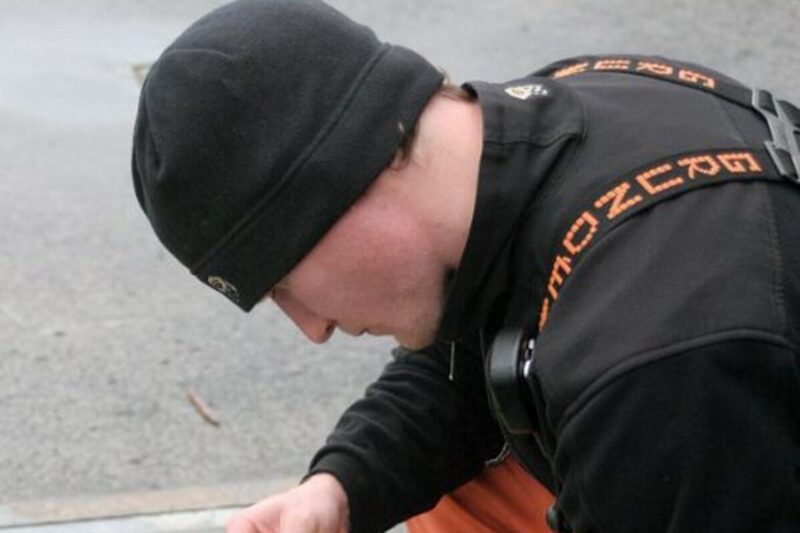Sean C. Morgan
South Santiam Hatchery steelhead smolts are busy taking one for their wild kin this month as they slide down a tube into and through the Foster Dam powerhouse turbines or over the spillway gates this month.
Researchers are trying to find the least harmful way for the young fish to make their way downstream.
The Corps is conducting tests to estimate the direct survival and injury rates of juvenile salmon and steelhead passing through the Foster Dam spillway and powerhouse at specific reservoir levels, said Spokesman Scott Clemens. “The tests will provide important data to the Corps and its partners about how best to manage operations at Foster and other dams to optimize fish passage and survival.”
Researchers pull juvenile steelhead from the South Santiam River below Foster Dam. The fish are located by brightly colored balloons, visible at the lower right, that force them to the surface. Once captured in the net, researchers remove the balloons and tags then transfer the fish to the South Santiam Fish Hatchery, where they are held for 48 hours for observation following their journey through the dam.
The tests are part of the Corps’ effort to implement the National Oceanic and Atmospheric Administration Fisheries and U.S. Fish and Wildlife services’ 2008 biological opinion, which specifies actions that the Corps and its partners, such as the Bonneville Power Administration, should take to reduce effects on upper Willamette River fish species listed in the Endanger Species Act, Clemens said.
When the Corps built the dam, “we stuck a great big stop sign in the middle of the river,” Clemens said. When Foster was built, that wasn’t considered a problem. The wild fish were simply going to be replaced by hatchery fish. U.S. understanding and values surrounding the fish have changed since then.
“We’re not just doing this because we’ve been told to do it,” Clemens said. Well before the opinion was issued in 2008, the Corps was trying to improve fish passage. Among its efforts has been a temperature control structure at Cougar Dam on the McKenzie River.
“Here at Foster Dam this fall, we’re going to start construction on an adult handling facility,” Clemens said. That facility will include a series of gates and corrals to separate hatchery and wild fish without handling them by hand. The fish will move through a water-to-water connection onto trucks for transport back downstream for hatchery fish and upstream for wild fish. Right now, the fish are collected into a single basket and separated by hand.
Some 1,200 Chinook salmon made their way upstream last year, Griffith said. That number is typically in the high hundreds.
Currently, the Corps lowers Foster Lake to 615 above sea level to allow juvenile steelhead and Chinook salmon passage downstream. Water rushes through a weir at about 300 cubic feet per second.
During the recent repairs to the Foster Dam spillway gates, the Corps ordered more stop logs, allowing the dam to place the weir higher, with a longer drop to the surface of the spillway, said Corps fish biologist Dave Griffith. Survival won’t be as good at the higher elevation, but raising the weir creates more distance between the entrance to the turbines and the weir, which means fewer fish overall will travel through the turbines, instead going over the spillway.
That move could result in a net increase in fish survival, Griffith said, but the Corps won’t know whether that’s true until it finishes testing.
The agency wants to improve survival and down-passage efficiency, which is the percentage of fish that find a way downstream, at its dams, he said, although down-passage efficiency isn’t a big issue at Foster.
In the testing, the Corps is comparing data from passage over the spillway at two different elevations and six different turbine blade configurations, including the angle of the blades and the amount of water passing through them. Juvenile hatchery steelhead, provided by the Oregon Department of Fish and Wildlife, are tagged and fitted with uninflated balloons.
The balloons fill with air using a chemical time-release mechanism, dragging the juveniles to the surface following their 60- to 90-second ride through the powerhouse or over the spillway.
Researchers collect the fish by boat and by net from the dam. The fish are transported to the South Santiam Hatchery and held for 48 hours to assess how many are injured or killed by the passage.
Sensor fish, a small tube with sensors and balloons, are also sent through the passages to measure the force, pressure and acceleration faced by the steelhead and salmon. Pressure affects the gases in the fishes’ blood as well as their swim bladders.
About a dozen researchers under contract with the Corps are working around the dam. The majority of them are from Pennsylvania.
Testing will continue through most of May, and Foster Dam Road is closed from 7 a.m. to 5 p.m. through May 24. One lane is open throughout the rest of the day.





